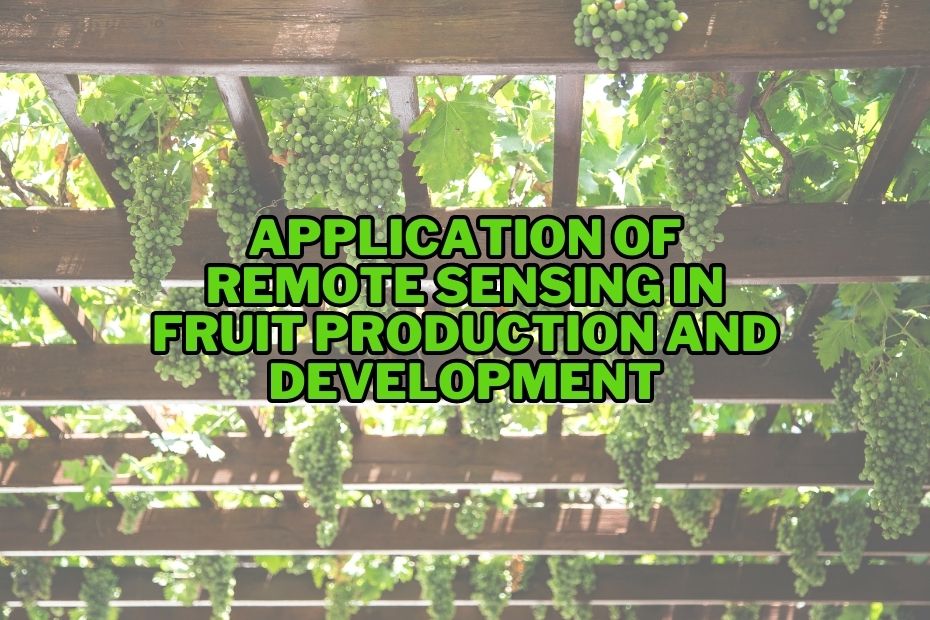Remote sensing technology has revolutionized various industries, and fruit production is no exception. By utilizing satellite imagery, drones, and other remote sensing tools, farmers and researchers can gather valuable information about orchards and crops. This article explores important application of remote sensing in fruit production and development, highlighting how this technology can enhance efficiency, yield, and sustainability in the agricultural sector.
Remote sensing applications in fruit production and development utilize satellite imaging and drone technology for real-time monitoring of crop health and growth patterns. These methods facilitate efficient irrigation, pest management, and yield prediction, thereby optimizing production processes and promoting sustainable practices in the fruit industry.
Application of Remote Sensing In Fruit Production and Development
The innovative application of remote sensing in agriculture, especially in fruit production, has been transformative. By integrating the use of advanced technology, we are experiencing higher yields, improved quality, and more sustainable practices in the sector. This article uncovers the benefits and practical aspects of this application.
1. Monitoring Soil Conditions
Remote sensing offers robust solutions for monitoring soil conditions. The technology captures and interprets data about soil moisture, composition, and temperature, providing farmers with valuable insights into soil health. The use of spectroscopy and radar imaging facilitates the mapping of soil properties, enhancing the effectiveness of fertilization and reducing nutrient waste.
2. Assessing Crop Health
The role of remote sensing in assessing crop health is vital. It allows farmers to monitor the spectral reflectance of crops, detect stress symptoms early and implement necessary measures to ensure optimal growth. The technology can identify nutrient deficiencies, signs of disease, and water stress, thereby allowing for timely intervention.
3. Optimizing Irrigation Practices
One key application of remote sensing is in the optimization of irrigation practices. Remote sensing devices monitor the water needs of fruit crops based on vegetation index and evapotranspiration data. Such information helps farmers adopt precision irrigation methods, reducing water waste and ensuring optimal crop growth.
4. Managing Pests and Weeds
Remote sensing aids in managing pests and weeds efficiently. The technology can help identify infestation hotspots and monitor the effectiveness of control measures. This approach not only reduces the cost of pest and weed management but also minimizes the environmental impact of pesticide and herbicide use.
5. Estimating Crop Yield
Through remote sensing, farmers can estimate crop yields more accurately. The technology enables the measurement of parameters like plant height, canopy density, and leaf area index. By analyzing these indicators, we can predict the fruit yield much earlier and more accurately than traditional methods.
6. Enhancing Harvest Quality
The use of remote sensing in enhancing harvest quality is invaluable. By analyzing spectral reflectance data, the technology can identify the optimal time for harvesting. This ensures that fruits are picked at peak ripeness, resulting in improved quality and consumer satisfaction.
7. Analyzing Canopy Health
Remote sensing can be instrumental in analyzing canopy health. By assessing parameters like chlorophyll content, leaf water content, and leaf area index, remote sensing devices can provide insights into the health and productivity of fruit trees. This information is critical for making informed management decisions and improving overall crop health.
8. Assessing Environmental Conditions
One crucial application of remote sensing in fruit production is assessing environmental conditions. Data on factors like temperature, humidity, rainfall, and sunlight exposure can help growers anticipate potential challenges and adapt their practices accordingly. This promotes resilience and ensures the sustainability of fruit production amidst climate change.
9. Mapping Fruit Orchards
Mapping fruit orchards is another vital application of remote sensing. It allows for precise orchard management and planning. Detailed maps enable efficient resource allocation, from irrigation planning to pest control, ensuring that all parts of the orchard receive the attention they need.
10. Predicting Harvest Timing
Remote sensing technology offers a reliable method for predicting harvest timing. By analyzing color index, firmness, and sugar content, this technology provides accurate estimates of fruit maturity. This not only helps farmers schedule harvesting but also assists in supply chain management and market planning.
The application of remote sensing in fruit production and development ushers in a new era of precision agriculture. With its numerous benefits, it revolutionizes the way we grow, manage, and harvest fruits. As we move forward, the adoption of this technology will undoubtedly be pivotal in meeting global food demand sustainably.
Conclusion:
Remote sensing has revolutionized fruit production and development by offering valuable insights into crop health, environmental conditions, and various other aspects of fruit cultivation. By leveraging remote sensing techniques, farmers can make informed decisions, optimize resource management, and enhance overall productivity and quality. As technology continues to advance, the applications of remote sensing in fruit production are expected to expand further, contributing to sustainable and efficient agricultural practices.
FAQs: Application of Remote Sensing In Fruit Production and Development
How does remote sensing benefit fruit production?
Remote sensing helps in monitoring crop health, detecting diseases, managing irrigation, predicting yields, and facilitating precision agriculture among other benefits.
How does remote sensing aid in irrigation management?
Remote sensing can identify areas in a field that are over or under-irrigated, thus guiding more efficient water use.
What does the future hold for remote sensing in fruit production?
The future of remote sensing in fruit production is promising, with advancements like nanosatellites and AI-driven data analysis set to further revolutionize the industry.
